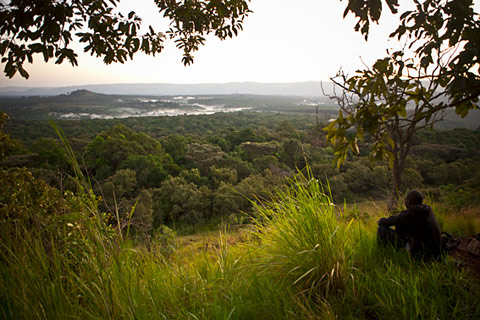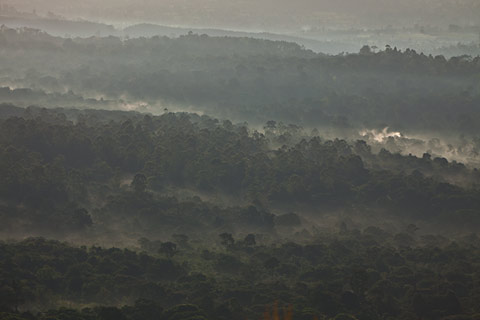
I was recently in Western Kenya. What was intended to be a quick stopover en route to Uganda turned into four days of rummaging through a rainforest with my camera wrapped in plastic shopping bags. As my “hotel” was without it, I had to hitch a ride on the back of a motorcycle to the nearest place with electricity so I could download images and charge batteries every night.

Not too long ago Africa’s midsection was a band of almost solid rainforest, stretching over six million square kilometers from West Africa along the Atlantic, through to the Central African Republic and the DRC, into East Africa. Today, the Guineo-Congolian rainforest, as it is known, is now just a remnant of what it once was, its canopies having suffered the impact of logging, oil and mineral exploration. In the case of the Kakamega Forest, large areas were cleared during colonial times to make way for large tea plantations. Below, children stand in front of tea fields along the the forest’s periphery.

While vast ares of the rainforest are still present in Central Africa, only a tiny section of it remains in Kenya, where it is now a protected area. The Kakamega Forest Reserve occupies 240 square kilometers in Western Kenya and contains huge varieties of birds, insects, snakes, plants and small mammals. Many of the plants in the forest are highly medicinal.

The most exhilarating of events for me came as I accompanied a group of forest rangers on their daily rounds through the reserve. Following behind these soldiers with loaded weapons in tow, through thick vegetation and winding streams, really got my adrenaline going. At one point we were in hot pursuit of some poachers who were cutting down a tree, but they managed to escape.

The area around the forest, though rural, is one of the most densely populated areas in Africa, with around 400 people per square kilometer on average at its western and southern perimeters. As the communities around the forest are impoverished, the pressure is great to exploit the forest for its vast stocks of wood to be used as firewood or made into charcoal. Arrests do occur here every day. Steep fines accompany arrests and increase with repeat infractions.

KEEP (Kakamega Environmental Education Program) is the government agency responsible for the care and protection of the forest. It also provides guides for tourists wishing to visit the reserve. These guides double as educators who teach environmental education awareness classes to children at the reserve headquarters on weekends, and also in public schools around the forest. Below, Mr. Abraham Imbai speaks to the Environmental Management and Conservation Club at Lunyu Secondary School.

“If we destroy the forest we lose rain.” says Maurine Cecilia, below, whose corn and herb gardens rely on the (usually) daily rainfall that results from the evaporation of the mist from the forest. Indeed, the land around the forest is extremely fertile, and farmers often reap several harvests a year because of the year-round rain. Soil erosion, a serious problem in most other parts of the county, is not an issue here.

Still many who live around the forest have little choice than to operate on the one day at a time mentality. “I know its illegal but its my responsibility to cook food for my family,” says one poacher (below, left) who along with her children have cut several fresh trees down and have to risk making three trips through the forest to take it all home.

Villagers are willing to risk fines in order to pilfer the abundant, free, firewood that comes out of the forest, especially if they can turn it into valuable, slow burning, charcoal. Though the production of charcoal is illegal, its lucrative rewards tempt some around the villages to produce and sell it. Below, men in the village of Virembe, on the forest’s western perimeter, smolder wood for charcoal.

“Right now there’s a total ban, but we’d like to allow it in order to bring prices down and discourage lucrative poaching,” says head Forester George Aimo. “If it was allowed under certain circumstances the forest would be better protected.” While there is an outright ban on charcoal production, it is permissible to collect dead wood in some areas of the reserve as long as the scavenger bears a receipt costing 100Ksh (USD $1.25) per month. The fine for a first time offense of collecting dry wood without a receipt, or felling trees or limbs is 2000 Ksh ($25 USD). Below, Mr. Patrick Asutzi, a KEEP employee, prepares seedlings for planting at the central ranger station.

Other problems in the forest include illegal logging, grazing and grass cutting. The A1 highway runs along the western edge of the forest making guerrilla logging easier. Villagers also graze their cattle in the periphery of the forest or even in the forest itself causing long term problems. “Overgrazing degrades the soil and inhibits regeneration of trees,” says Forester Aimo. Below, a man cuts grass in a high glen in the forest.


Above, a Black and White Colobus Monkey hides in the treetops. Its numbers have boomed back in the forest since the time when they were hunted for their fur, which was used in ceremonial garb. Today the monkey is still endangered, as the tree whose leaves are crucial to its digestion, the sandpaper tree, is also in danger due to logging and predation from pest trees in the forest. These predator species wrap themselves around other trees and over years suffocate them to death (see below).


We can never convince an entire generation that it must make sacrifices in order to provide quality of life for those to come, but for the most part KEEP is succeeding in this. Though serious problems exist, the forest not only remains but in some areas is growing. For the moment life is abundant here, though it is not without heavy cost and toil.
